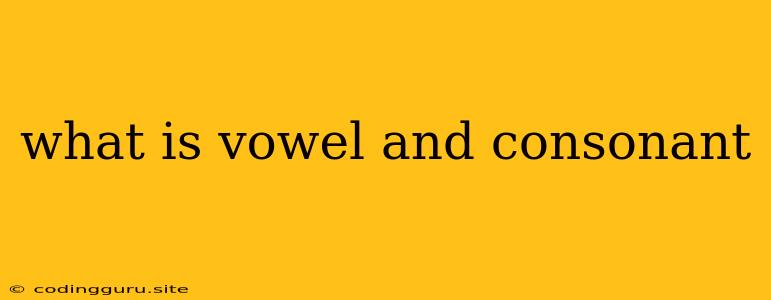What Are Vowels and Consonants?
The building blocks of language are vowels and consonants. They are the sounds we make when we speak, and they combine to form words. But what exactly are they, and how do they differ?
Vowels: The Open Sounds
Vowels are sounds created by the free flow of air through the mouth. There's no obstruction or narrowing of the vocal tract. Think of it like singing "ah" or "ee" - your mouth is open, and the air flows freely.
Here's a breakdown of what makes vowels unique:
- Open mouth: The tongue isn't touching the roof of your mouth or any other part of your mouth.
- Airflow: Air flows easily and without obstruction.
- Sound production: The sound is produced by the vibration of the vocal cords.
Examples of vowels:
- a as in cat
- e as in bed
- i as in bit
- o as in hot
- u as in cup
Consonants: The Restricted Sounds
Unlike vowels, consonants involve a partial or complete closure of the mouth, creating a restricted airflow. This restriction can be caused by the tongue, teeth, or lips. Imagine saying "b" or "t" – you feel the obstruction and the air flow is partially blocked.
Here's what makes consonants different from vowels:
- Obstructed airflow: The air flow is either partially or completely blocked.
- Tongue position: The tongue touches the roof of your mouth, teeth, or lips to create the obstruction.
- Sound production: Sound can be produced by the vibration of the vocal cords or by the noise of air being released.
Examples of consonants:
- b as in bat
- d as in dog
- f as in fan
- g as in gate
- h as in hat
- j as in jam
- k as in kick
- l as in lamp
- m as in man
- n as in net
- p as in pen
- r as in run
- s as in sun
- t as in top
- v as in van
- w as in wet
- x as in box
- y as in yes
- z as in zip
The Importance of Vowels and Consonants
Understanding vowels and consonants is crucial for learning any language. They form the foundation of spoken and written words, and their interplay creates the unique sounds and rhythms of different languages. Here are some key reasons why they are important:
- Pronunciation: Correctly identifying vowels and consonants is vital for accurate pronunciation.
- Reading: Understanding vowels and consonants is essential for decoding written words.
- Writing: Knowing the relationship between letters and sounds is crucial for spelling words correctly.
- Language development: Recognizing and manipulating vowels and consonants is a fundamental step in early language development.
Learning Tips
Learning about vowels and consonants can be fun and rewarding. Here are some tips for mastering them:
- Practice speaking: Regularly say vowels and consonants aloud to solidify their sounds in your mind.
- Focus on the mouth: Observe the position of your tongue, teeth, and lips as you make different sounds.
- Use visual aids: Diagrams or charts showing the positions of vowels and consonants in the mouth can be helpful.
- Break down words: When you encounter a new word, try breaking it down into its individual vowels and consonants.
- Sing and rhyme: Singing and reciting rhymes helps you practice the sounds of vowels and consonants in a fun and engaging way.
Conclusion
Vowels and consonants are the foundational elements of language. They are the sounds we make when we speak, and their interplay creates the richness and diversity of human communication. By understanding their characteristics and their role in language, we can gain a deeper appreciation for the complexities of language and improve our own communication skills.
